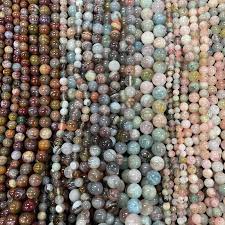
Jul 06 , 2024
The Fascinating World of Beads: A Journey Through History, Culture, and Craftsmanship
Beads, small and often round objects crafted from a variety of materials, have played a significant role in human history for thousands of years. They are more than just decorative items; they are cultural rtefacts that tell stories of trade, spirituality, social status, and artistic expression. Let's delve into the captivating world of beads and explore their diverse history, cultural significance, and intricate craftsmanshipa.
The History of Beads
Ancient Beginnings
Beads are among the earliest forms of human adornment, with some of the oldest beads dating back over 100,000 years. Early humans created beads from natural materials such as shells, bones, stones, and seeds. These ancient beads were often used as personal adornments, symbols of status, or in religious rituals.
Trade and Exchange
Throughout history, beads have been a valuable trade commodity. The exchange of beads facilitated interactions between different cultures and societies. For example, during the Roman Empire, glass beads were traded extensively across Europe, Africa, and Asia. In Africa, the arrival of European traders brought an influx of glass beads, which became integral to many African cultures.
Beads in Art and Decoration
Beads have also been used in art and decoration. Intricate beadwork can be found in ancient Egyptian tombs, Native American regalia, and traditional African attire. Beaded artworks often carry deep symbolic meanings and showcase the craftsmanship and creativity of different cultures.
Types of Beads
Glass Beads
Glass beads are perhaps the most diverse and widely used type of bead. They come in various shapes, sizes, and colors, and have been produced since ancient times. Notable examples include Venetian glass beads, known for their intricate designs, and Czech glass beads, renowned for their high quality and variety.
Stone and Gemstone Beads
Stone and gemstone beads are valued for their natural beauty and durability. Semi-precious stones such as turquoise, amethyst, and jade are commonly used in bead making. These beads are often believed to have metaphysical properties, providing spiritual and healing benefits to the wearer.
Metal Beads
Metal beads, made from gold, silver, brass, and copper, have been used since ancient times. They are often used to create jewelry and decorative items that symbolize wealth and power. Metal beads can be plain or intricately designed with patterns and engravings.
Organic Beads
Organic beads are made from natural materials such as wood, seeds, bone, and shell. These beads are often associated with traditional and indigenous cultures. For example, Native American tribes use bone and shell beads in their ceremonial attire, while African artisans craft beads from seeds and wood.
Plastic Beads
Plastic beads, introduced in the 20th century, are inexpensive and versatile. They are commonly used in costume jewelry, crafts, and children's projects. While they lack the historical significance and natural beauty of other types, plastic beads have made beadwork accessible to a broader audience.
Cultural Significance of Beads
African Beadwork
In Africa, beads hold immense cultural significance. They are used in various ceremonies, including weddings, funerals, and initiations. Each bead's color, size, and material carry specific meanings. For instance, in the Yoruba culture of Nigeria, coral beads symbolize royalty and status.
Native American Beadwork
Native American beadwork is renowned for its intricate designs and symbolic meanings. Beads are used to create elaborate clothing, accessories, and ceremonial items. Each tribe has its unique beadwork style, often passed down through generations.
Asian Bead Traditions
In Asia, beads have been used in religious practices, trade, and adornment. Buddhist prayer beads, known as malas, are used for meditation and chanting. In India, beads made from rudraksha seeds are considered sacred and are used in spiritual practices.
European Bead History
In Europe, beads have been used since ancient times for decoration and trade. The Renaissance period saw a surge in the popularity of glass beads, particularly in Venice. Today, European beads, such as those from Murano, are still highly prized for their craftsmanship.
The Craftsmanship of Bead Making
Traditional Techniques
Bead making is a highly skilled craft that has been refined over centuries. Traditional techniques include:
- Glass Bead Making: Involves melting glass rods and shaping them into beads using a torch or furnace. Venetian and Czech glass beads are famous examples.
- Stone Carving: Gemstone beads are carved and polished to enhance their natural beauty.
- Metalworking: Metal beads are cast, hammered, or engraved to create intricate designs.
- Organic Bead Crafting: Involves carving, drilling, and polishing natural materials like wood, bone, and shell.
Modern Innovations
Modern technology has introduced new materials and methods in bead making. Plastic beads, synthetic gemstones, and mass production techniques have expanded the variety and accessibility of beads. However, traditional handmade beads remain highly valued for their uniqueness and craftsmanship.
Conclusion
Beads are more than just decorative objects; they are a testament to human ingenuity, creativity, and cultural expression. From ancient trade routes to modern fashion runways, beads have traveled across time and space, connecting people and cultures. By understanding the history, types, and cultural significance of beads, we can appreciate the artistry and stories they carry, ensuring that this timeless craft continues to inspire and enchant future generations.



